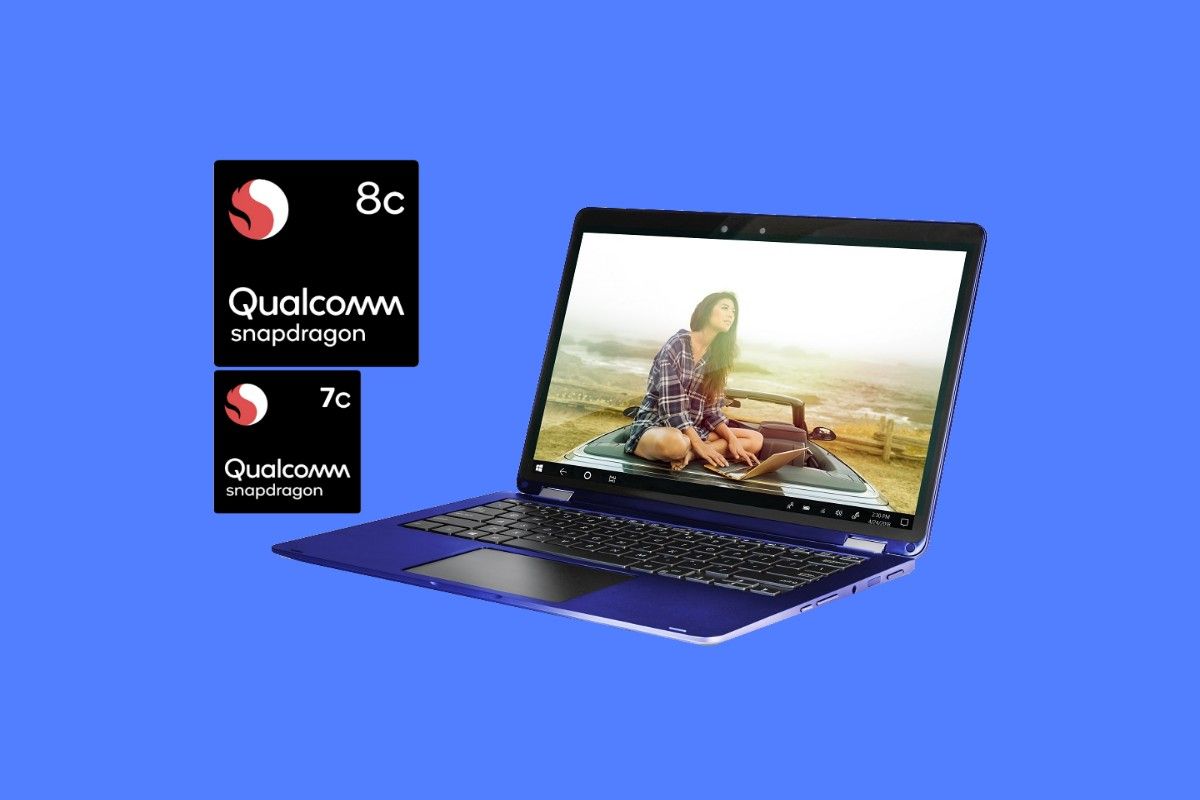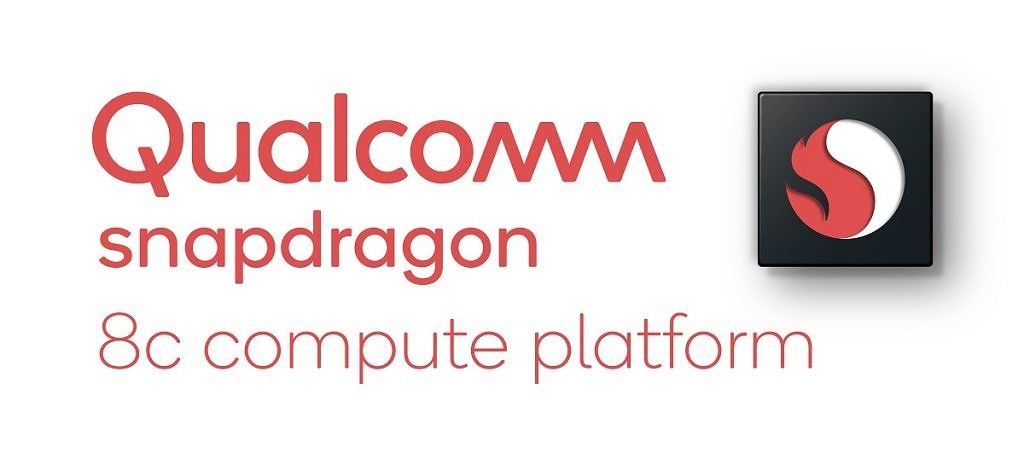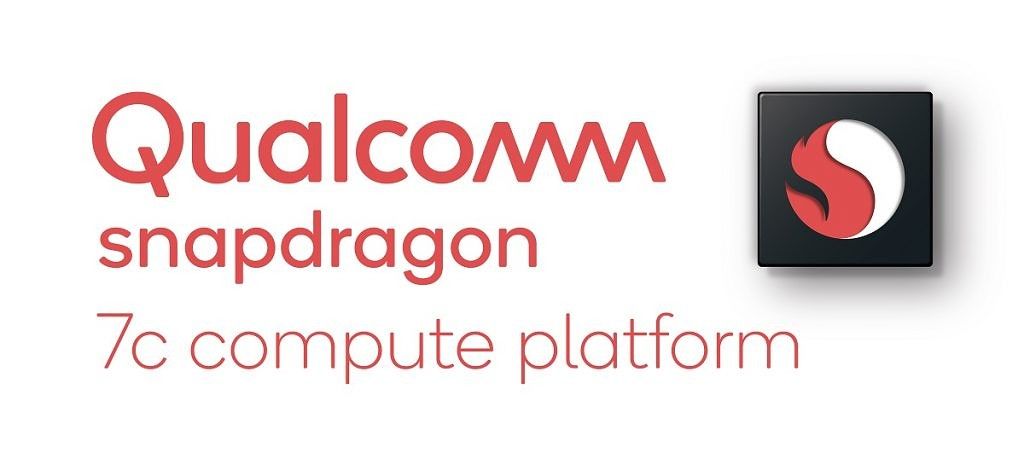Last year, Qualcomm announced the Snapdragon 8cx 5G platform, the world’s first 7nm SoC for laptops, in an attempt to capture the growing market of hybrid, thin-and-light always-connected personal computers (ACPCs). This was the latest in a series of Qualcomm chips for ACPC as the company had previously tested the waters with the Snapdragon 850 and Snapdragon 835 Mobile PC platforms. While we saw Snapdragon 835-powered Windows 10 ACPCs as early as 2018, the Snapdragon 850 was even better tailored for Windows on ARM, which was brought about by concerted effort from Microsoft and Qualcomm. Now, at this year’s Snapdragon Tech Summit, the ACPC chipset portfolio is expanding with the announcement of the new Snapdragon 8c and Snapdragon 7c mobile PC platforms.
These mobile processors allow hybrid and thin-and-light laptops to make use of the integrated modem in Snapdragon chips, and also take advantage of the higher power-efficiency for extended battery life. Those looking for ACPC devices usually prioritize mobility and battery life, thus these efficient Qualcomm chipsets with LTE connectivity are a great fit for on-the-go devices. While ACPC use cases do not require a ton of performance, last year’s Snapdragon 8cx brought about a higher power budget and even better efficiency point for impressive results. The 8cx was essentially a larger Snapdragon 855, featuring the same 8th generation Kryo 495 cores in a 4+4 configuration as well as the Adreno 680 GPU. However, it also came with improvements tailored to the form factor, such as double the memory width through a 128-bit wide interface, capable of up to 16GB of LPDDR4X RAM, and more PCIe connections. This new premium computing tier was not meant to replace the Snapdragon 850, but rather coexist with it by giving OEMs more options when picking the right processor for their ACPC.
This new effort by Qualcomm has seen marked success, even subtly making headlines through the Surface Pro X and its Microsoft SQ1 chip, a Snapdragon 8cx derivative with an upgraded Adreno 685 GPU. This is where the Snapdragon 8c and Snapdragon 7c come into play: While 855-based designs have already made their mark in the premium segment through devices like the Surface Pro X (Microsoft SQ1) and the Galaxy Book S (running the 8cx), the Snapdragon 850 chips are due for an update. Thus, Qualcomm has introduced the high-end Snapdragon 8c, which it directly compares with the Snapdragon 850, and the Snapdragon 7c aimed at entry-level devices.
The Snapdragon 8c succeeds the Snapdragon 850, similarly to the 8cx at the time, with a CPU performance boost of up to 30%. Just like the preceding 8cx, the Snapdragon 8c is built on a 7nm manufacturing process. We can’t directly contrast this figure with the gains the 8cx promised over the 850 given that, at the time, Qualcomm had not offered us a percentage improvement figure. Though, expect the 8cx to remain the better-performing solution. It also promises up to 6 TOPS through its updated Qualcomm AI Engine, combining performance gains in CPU, GPU, and DSP. Finally, its integrated Snapdragon X24 LTE modem enables multi-gigabit connectivity with Cat. 20 downlink for download speeds of up to 2Gbps and Cat. 13 uplink for upload speeds of up to 316Mbps.
Qualcomm Snapdragon 8c complete feature list. Click to expand.
-
-
Advanced Camera and Video capabilities: Cinema core with VP9 & H.265 decoder and 2nd Gen HDR Playback; High efficiency video encoder
-
Dual 4K external displays
-
Connected Standby / Instant On
-
Multi-gigabit speeds for virtually seamless cloud connectivity/computing: up to 2Gbps LTE
-
Location Aware for app accuracy
-
Wi-Fi: MU-MIMO, Multi-gigabit Wi-Fi, Dual-band simultaneous (DBS), Integrated baseband
-
4th Generation Qualcomm AI Engine
-
Enhanced voice assistant experiences for Alexa and Cortana with Qualcomm Aqstic technology
-
Supports all Windows 10 versions (Enterprise, Pro, Home)
-
-
Remote management and location awareness for enterprise efficiency
-
Advanced location features:
- Low Power Geofencing and Tracking
- Sensor-assisted Navigation
- Pedestrian Navigation
-
Sensors: Qualcomm® All-Ways Aware™ technology
-
Charging: Qualcomm® Quick Charge™ 4+ technology
Qualcomm Snapdragon 8c specifications. Click to expand.
5G
- 5G Chipset: Qualcomm® Snapdragon™ X55 Modem-RF System
- 5G Technology: 5G NR
- 5G Spectrum: 5G/4G spectrum sharing, mmWave, sub-6 GHz
- 5G Modes: FDD, TDD, SA (standalone), NSA (non-standalone)
- 5G mmWave specs: 800 MHz bandwidth, 8 carriers, 2x2 MIMO
- 5G sub-6 GHz specs: 200 MHz bandwidth, 4x4 MIMO
- 5G Peak Download Speed: 7 Gbps
- 5G Peak Upload Speed: 3 Gbps
- 5G RF: 100 MHz envelope tracking, Adaptive antenna tuning
Qualcomm® Artificial Intelligence (AI) Engine
- AIE DSP: Qualcomm All-Ways Aware™ technology
CPU
- CPU Clock Speed: Up to 2.45 GHz
- CPU Cores: Qualcomm® Kryo™ 490 CPU, Octa-core CPU
- CPU Architecture: 64-bit
DSP
- DSP Technology: Qualcomm® Hexagon™ 690 Processor
Cellular Modem
- Modem Name: Qualcomm® Snapdragon™ X24 LTE modem
LTE Category
- Downlink LTE Category: LTE Category 20
LTE Downlink Features
- Downlink LTE Streams: Maximum 20 spatial streams
- Downlink Carrier Aggregation: 7x20 MHz carrier aggregation
- Downlink LTE MIMO: Up to 4x4 MIMO on five carriers, Full-Dimension MIMO (FD-MIMO)
- Downlink QAM: Up to 256-QAM
LTE Uplink Features
- Uplink Technology: Qualcomm® Snapdragon™ Upload+
- Uplink Carrier Aggregation: 3x20 MHz carrier aggregation
- Uplink LTE Streams: Up to 2x 106Mbps LTE streams
- Uplink QAM: Up to 256-QAM
LTE Speed
- LTE Peak Download Speed: 2 Gbps
- LTE Peak Upload Speed: 316 Mbps
Cellular Technology
- Cellular Technology: WCDMA (DB-DC-HSDPA, DC-HSUPA), TD-SCDMA, CDMA 1x, EV-DO, GSM/EDGE
- LTE Technology: LTE FDD, LTE TDD including CBRS support, LAA, LTE Broadcast
Wi-Fi
- Wi-Fi Standards: 802.11ad, 802.11ac Wave 2, 802.11a/b/g, 802.11n
- Wi-Fi Spectral Bands: 2.4 GHz, 5 GHz, 60 GHz
- MIMO Configuration: 2x2 (2-stream)
Bluetooth
- Bluetooth Version: Bluetooth 5.0
NFC
- Near Field Communications: Supported
Location
- Satellite Systems Support: Beidou, Galileo, GLONASS, GPS, QZSS
- Location Support: Qualcomm® Location
- Global Emergency Services Support: Assisted GPS, OTDOA (LTE-based positioning)
RF
- RFFE: Qualcomm® RF Front-End (RFFE) solution, High-power transmit (HPUE), Qualcomm® Adaptive Antenna Tuning
Camera
- Image Signal Processor: Qualcomm Spectra™ 390 image signal processor, Dual 14-bit ISPs
- Dual Camera: Up to 16 MP
- Single Camera: Up to 32 MP
- Video Capture (30 FPS): 4K HDR video capture, 4K Ultra HD video capture
- Slow Motion Video Capture: 720p @ 480 FPS
Video
- Video Playback: Up 4K HDR @ 120fps
- Codec Support: H.265 (HEVC), H.264 (AVC), VP9
- Video Software: Rec. 2020 color gamut video capture, Up to 10-bits per color video capture
Display
- Max On-Device Display: 4K Ultra HD
- Max External Display: Two 4K Displays
General Audio
- Audio Technology: Qualcomm TrueWireless™ Technology, Qualcomm® Broadcast Audio technology, Qualcomm Aqstic™ audio technology, Qualcomm® aptX™ audio technology
- Qualcomm® aptX™ audio playback support: Qualcomm® aptX™, Qualcomm® aptX™ HD
Audio Playback
- Channel output: Surround Sound
- Speaker protection: Speaker protection
GPU
- GPU Name: Qualcomm® Adreno™ 675 GPU
- API Support: DirectX® 12
Memory
- Memory speed: 2133MHz
- Memory Type: 4 channels
Storage
- SSD: NVME SSD
- UFS: UFS 3.0
The Snapdragon 7c is arguably an even more interesting portfolio addition given it's aimed at more affordable ACPCs. Its octa-core Kryo 468 CPU cores promise a 25% boost in system performance over competing platforms in the same segment, and up to twice the battery life in day-to-day usage. It also offers the Snapdragon X15 LTE modem for fast connectivity, with LTE download and upload speeds of 800Mbps and 150Mbps, respectively. It features an Adreno 618 GPU as well, putting ahead of the Snapdragon 835 Mobile PC platform but behind the Snapdragon 850. Finally, it promises up to 5 TOPS through its Qualcomm AI engine, putting the CPU, GPU, and DSP gains to good use in AI-accelerated Windows 10 experiences.
Qualcomm Snapdragon 7c complete feature list. Click to expand.
-
Wi-Fi 6 (11ax) ready (8ss and TWT), Advanced DPD, WPA3
-
Multi-Frame Noise Reduction (MFNR) and Multi-Frame Super Resolution (MFSR)
-
Forward-looking Electronic Image Stabilization (EIS)
-
Motion Compensated Temporal filtering (MCTF) for noise-free video capture up to UHD (4K) at 30 FPS
-
Four MIPI CSI PHYs (DPHY 1.2 / CPHY 1.2)
Qualcomm Snapdragon 7c specifications. Click to expand.
Qualcomm® Artificial Intelligence (AI) Engine
- AIE CPU: Qualcomm® Kryo™ 468 CPU
- AIE GPU: Qualcomm® Adreno™ 618 GPU
CPU
- CPU Clock Speed: Up to 2.45 GHz
- CPU Cores: Qualcomm® Kryo™ 468 CPU, Octa-core CPU
- CPU Architecture: 64-bit
Qualcomm® FastConnect™ Subsystem
- Bluetooth Version: Bluetooth 5.1
Cellular Modem
- Modem Name: Qualcomm® Snapdragon™ X15 LTE modem
LTE Category
- Downlink LTE Category: LTE Category 15
- Uplink LTE Category: LTE Category 13
LTE Downlink Features
- Downlink Carrier Aggregation: 3x20 MHz carrier aggregation
- Downlink LTE MIMO: Up to 4x4 MIMO on two carriers
- Downlink QAM: Up to 256-QAM, Up to 64-QAM
LTE Uplink Features
- Uplink Technology: Qualcomm® Snapdragon™ Upload+
- Uplink Carrier Aggregation: 2x20 MHz carrier aggregation
- Uplink QAM: Up to 64-QAM
LTE Speed
- LTE Peak Download Speed: 800 Mbps, 150 Mbps
Wi-Fi
- Wi-Fi Standards: 802.11ax (Wi-Fi 6-ready)
- Wi-Fi Spectral Bands: 2.4 GHz, 5 GHz
- MIMO Configuration: 2x2 (2-stream)
- Wi-Fi Features: Target Wake-up Time (TWT)
Location
Satellite Systems Support: NavIC, Beidou, Galileo, GLONASS, GPS, QZSS, SBAS
Camera
- Image Signal Processor: Qualcomm Spectra™ 255 image signal processor, 14-bit
- Dual Camera, ZSL, 30fps: Up to 16 MP
- Single Camera, ZSL, 30fps: Up to 32 MP
- Camera Features: Multi-frame Noise Reduction (MFNR)
- Video Capture Features: Rec. 2020 color gamut video capture, Up to 10-bit color depth video capture
Video
- Video Playback: Up to 4K HDR10
- Codec Support: H.265 (HEVC), H.264 (AVC), VP9
- Video Software: Motion Compensated Temporal Filtering (MCTF)
Display
- Max On-Device Display: QXGA @ 60Hz, FHD @ 60Hz
- Max External Display: QHD @ 60Hz
- Display Pixels: 2560x1440, 2048x1536
General Audio
- Qualcomm Aqstic™ technology: Qualcomm Aqstic™ audio codec, Qualcomm Aqstic™ smart speaker amplifier
- Qualcomm® aptX™ audio playback support: Qualcomm® aptX™, Qualcomm® aptX™ HD
Audio Playback
- PCM, Playback: Up to 384kHz/32bit
- Additional Playback Features: Native DSD support
Memory
- Memory speed: 2133MHz
- Memory Type: 2x16bit, LPDDR4
- RAM: 10 GB RAM
Notably absent from these chipsets is 5G connectivity, though this may not be too surprising considering that the 8cx already fulfills that role for the few premium-tier devices aiming for that functionality (855-based ACPCs like the Surface Pro X and Galaxy Book S skipped 5G anyway). According to Patrick Moorhead, Founder and President at Moor Insights & Strategy, Qualcomm is targeting the Snapdragon 7c to the sub-$400 price point and the Snapdragon 8c to the $400-$800 price point, with the Snapdragon 8cx filling the above-$800 premium tier. Devices with the two new platforms are expected to launch in the first half of 2020.
Stay tuned for more Snapdragon Tech Summit coverage, and check out our summary to catch up with every announcement!



